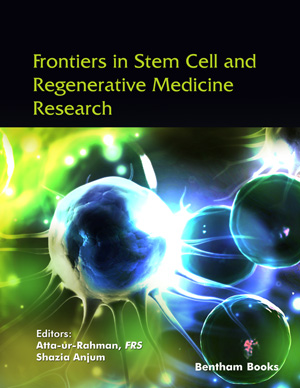
Abstract
Background: The consistent, self-renewal capability and wide-ranged differentiation potential during specific physiologic conditions mark stem cells as a novel candidate not only for biomedical research and regenerative therapy but also as an alternative source in research related to life sciences. This vital and distinct characteristic of stem cells enables them to offer unprecedented hope in treating many diseases and disorders, which are otherwise difficult to treat. Several efforts are still being undertaken to enhance the efficiency of MSCs for better therapeutic applications.
Objective: In the recent past, several studies have been conducted regarding the isolation of stem cells from diverse sources and are being used clinically in veterinary regenerative therapy. However, to date, only a few systemic studies are available. This study provides a comprehensive analysis of the findings from basic and applied research conducted on stem cell therapeutics with particular emphasis on animals.
Result: On the basis of their sources, stem cells can be classified as adult or embryonic stem (ES) cells. Physiologically, the ES cells have the capability to differentiate into all body cells and develop into the normal adult organism, whereas adult stem cells serve as a repair system by restoring damaged tissues of the body. The adult stem cells referred to as Mesenchymal stem cells (MSCs) can be derived from various adult body organs, whereas embryos give rise to embryonic stem cells. MSCs possess the unique property of proliferation, trans-differentiation, and secretion of important biomolecules to create a microenvironment, which is immunosuppressive and stimulates native MSCs of damaged tissue. MSCs being immunocompromised cells can be used in autologous as well as in allogenic mode.
Conclusion: In veterinary therapeutics, MSCs equipped with engineering and pharmaceutical modifications are offered as potential candidates in the treatment of wound healing, nerve injury, bone/ligament injury, etc., and also bear a great hope for the improvement of udder health and milk production in animals.
Keywords: Mesenchymal stem cell, immunosuppression, secretome, regenerative therapy, ageing, genetic engineering.
[http://dx.doi.org/10.4172/2157-7633.1000141]
[http://dx.doi.org/10.1002/jcp.27086] [PMID: 30132873]
[http://dx.doi.org/10.1002/jcp.29486] [PMID: 31960454]
[http://dx.doi.org/10.1016/j.cytogfr.2009.10.002] [PMID: 19926330]
[http://dx.doi.org/10.1042/BST0331526] [PMID: 16246161]
[http://dx.doi.org/10.1097/00007890-196803000-00009] [PMID: 5654088]
[http://dx.doi.org/10.1002/jor.1100090504] [PMID: 1870029]
[http://dx.doi.org/10.1038/nature05574] [PMID: 17330052]
[http://dx.doi.org/10.1093/intimm/dxq039]
[http://dx.doi.org/10.1111/j.2042-3306.2011.00363.x] [PMID: 21615465]
[http://dx.doi.org/10.1371/journal.pone.0075697] [PMID: 24086616]
[http://dx.doi.org/10.1111/rda.12499] [PMID: 25703812]
[http://dx.doi.org/10.1186/1477-7827-4-8] [PMID: 16460563]
[http://dx.doi.org/10.2478/s11658-011-0019-7] [PMID: 21786036]
[http://dx.doi.org/10.3324/haematol.11869] [PMID: 18268281]
[http://dx.doi.org/10.1016/j.rvsc.2013.01.011] [PMID: 23414969]
[http://dx.doi.org/10.1007/s11259-014-9597-y] [PMID: 24604133]
[http://dx.doi.org/10.3923/ajava.2015.537.548]
[http://dx.doi.org/10.1097/01.TP.0000082540.43730.80] [PMID: 14578755]
[http://dx.doi.org/10.1634/stemcells.2006-0686] [PMID: 17540857]
[http://dx.doi.org/10.1080/10495398.2015.1118383] [PMID: 26913553]
[http://dx.doi.org/10.1126/science.284.5411.143] [PMID: 10102814]
[http://dx.doi.org/10.1006/excr.2001.5278] [PMID: 11478845]
[http://dx.doi.org/10.1016/j.yexcr.2005.03.018] [PMID: 15925588]
[http://dx.doi.org/10.1161/01.cir.0000089186.09692.fa] [PMID: 12970242]
[http://dx.doi.org/10.1016/S0014-4827(03)00132-0] [PMID: 12878158]
[http://dx.doi.org/10.2174/1574888X13666180517074444] [PMID: 29769009]
[http://dx.doi.org/10.1002/jor.1100150410] [PMID: 9379264]
[http://dx.doi.org/10.1634/stemcells.2006-0208] [PMID: 17124009]
[http://dx.doi.org/10.1002/jcb.24377] [PMID: 22949406]
[http://dx.doi.org/10.1155/2014/216806] [PMID: 25025040]
[http://dx.doi.org/10.1111/j.1365-2796.2007.01844.x] [PMID: 17949362]
[http://dx.doi.org/10.1186/s13287-019-1224-y] [PMID: 31046833]
[http://dx.doi.org/10.1182/blood-2003-04-1193] [PMID: 12881305]
[http://dx.doi.org/10.1182/blood.V99.10.3838] [PMID: 11986244]
[http://dx.doi.org/10.1186/s13287-019-1300-3] [PMID: 31238978]
[PMID: 15820948]
[http://dx.doi.org/10.1111/j.1365-2249.2011.04327.x] [PMID: 21352202]
[http://dx.doi.org/10.1111/j.1749-6632.2009.04607.x] [PMID: 19796238]
[http://dx.doi.org/10.1634/stemcells.2005-0008] [PMID: 16123384]
[http://dx.doi.org/10.1182/blood-2005-07-2657] [PMID: 16141348]
[http://dx.doi.org/10.1182/blood-2007-02-074997] [PMID: 17951526]
[http://dx.doi.org/10.1155/2010/865601] [PMID: 20628526]
[http://dx.doi.org/10.1634/stemcells.2005-0319] [PMID: 16253981]
[http://dx.doi.org/10.3324/haematol.10669] [PMID: 17606439]
[http://dx.doi.org/10.1038/cmi.2012.40] [PMID: 23085948]
[http://dx.doi.org/10.3727/096368912X653246] [PMID: 22889699]
[http://dx.doi.org/10.1038/s41598-020-58909-4] [PMID: 32034203]
[http://dx.doi.org/10.3109/14653249.2011.651532] [PMID: 22264191]
[http://dx.doi.org/10.1016/j.bbrc.2010.09.076] [PMID: 20869949]
[PMID: 18830918]
[http://dx.doi.org/10.1016/j.bbmt.2005.02.001] [PMID: 15846293]
[http://dx.doi.org/10.1002/sctm.18-0226] [PMID: 31045328]
[http://dx.doi.org/10.1016/j.ijpharm.2017.02.038] [PMID: 28216464]
[http://dx.doi.org/10.1007/978-1-4939-8697-2_6] [PMID: 30196403]
[http://dx.doi.org/10.1038/s41580-020-0251-y] [PMID: 32457507]
[http://dx.doi.org/10.1186/2001-1326-3-24] [PMID: 25097727]
[http://dx.doi.org/10.1038/nm.3651] [PMID: 25100532]
[http://dx.doi.org/10.1083/jcb.201010131] [PMID: 21502357]
[http://dx.doi.org/10.5493/wjem.v7.i1.1] [PMID: 28261550]
[http://dx.doi.org/10.1038/nature11438] [PMID: 23023126]
[http://dx.doi.org/10.1126/science.1144090] [PMID: 17690295]
[http://dx.doi.org/10.1002/stem.121] [PMID: 19544416]
[http://dx.doi.org/10.4161/15384101.2014.965072] [PMID: 25485497]
[http://dx.doi.org/10.1038/nature05091] [PMID: 16957738]
[http://dx.doi.org/10.3389/fcell.2014.00010] [PMID: 25364718]
[http://dx.doi.org/10.1038/nature13013] [PMID: 24522534]
[http://dx.doi.org/10.1186/s13287-016-0303-6] [PMID: 26960535]
[http://dx.doi.org/10.1039/C8TB02759E] [PMID: 32073579]
[http://dx.doi.org/10.2217/rme-2018-0138] [PMID: 32154762]
[http://dx.doi.org/10.1016/j.jpedsurg.2018.09.024] [PMID: 30429066]
[http://dx.doi.org/10.1016/j.biopha.2019.109573] [PMID: 31810116]
[http://dx.doi.org/10.1007/s10856-013-5031-1] [PMID: 23999881]
[http://dx.doi.org/10.1016/j.actbio.2017.10.007] [PMID: 28987783]
[http://dx.doi.org/10.5966/sctm.2014-0007] [PMID: 25038246]
[http://dx.doi.org/10.1089/scd.2011.0634] [PMID: 22309189]
[http://dx.doi.org/10.1681/ASN.2008070798] [PMID: 19389847]
[http://dx.doi.org/10.1007/s10439-014-1010-z] [PMID: 24788648]
[http://dx.doi.org/10.1161/CIRCULATIONAHA.107.715847] [PMID: 18040029]
[http://dx.doi.org/10.1111/vde.12011] [PMID: 23432413]
[http://dx.doi.org/10.1002/ccr3.253] [PMID: 26273450]
[http://dx.doi.org/10.1001/archderm.139.4.510] [PMID: 12707099]
[http://dx.doi.org/10.1164/rccm.201001-0010OC] [PMID: 20558630]
[http://dx.doi.org/10.1089/wound.2015.0635] [PMID: 26339534]
[http://dx.doi.org/10.14737/journal.aavs/2014/2.3.188.191]
[http://dx.doi.org/10.1097/PRS.0b013e3181eae781] [PMID: 20885241]
[http://dx.doi.org/10.1038/srep18844] [PMID: 26728342]
[http://dx.doi.org/10.1523/JNEUROSCI.21-10-03392.2001] [PMID: 11331369]
[http://dx.doi.org/10.1111/j.1460-9568.2004.03657.x] [PMID: 15379990]
[http://dx.doi.org/10.1371/journal.pone.0035577] [PMID: 22523602]
[http://dx.doi.org/10.1186/s12974-015-0402-9] [PMID: 26415563]
[PMID: 4846478]
[http://dx.doi.org/10.1038/nn1195] [PMID: 14966523]
[http://dx.doi.org/10.1523/JNEUROSCI.4070-05.2005] [PMID: 16495442]
[http://dx.doi.org/10.1186/scrt32] [PMID: 20977782]
[http://dx.doi.org/10.1097/00005131-198909000-00002] [PMID: 2809818]
[http://dx.doi.org/10.1002/jso.24234] [PMID: 27126893]
[http://dx.doi.org/10.1155/2019/4587594]
[http://dx.doi.org/10.1002/art.24443]
[http://dx.doi.org/10.1016/j.stem.2011.06.008]
[http://dx.doi.org/10.1210/er.2003-0027] [PMID: 15294883]
[http://dx.doi.org/10.1155/2013/416391] [PMID: 24307997]
[PMID: 23738300]
[http://dx.doi.org/10.1002/jor.20071] [PMID: 16649228]
[http://dx.doi.org/10.1002/jor.20456] [PMID: 17676628]
[http://dx.doi.org/10.1016/j.rvsc.2013.01.017] [PMID: 23419936]
[http://dx.doi.org/10.1080/01652176.2014.949390] [PMID: 25072527]
[http://dx.doi.org/10.3727/105221611X13176664479368] [PMID: 22268295]
[http://dx.doi.org/10.1038/nature04496] [PMID: 16395311]
[http://dx.doi.org/10.1016/S0040-8166(02)00107-6] [PMID: 12747930]
[http://dx.doi.org/10.1080/01652176.2014.894262] [PMID: 24624999]
[http://dx.doi.org/10.1007/s10911-005-2536-3] [PMID: 15886882]
[http://dx.doi.org/10.3181/0811-RM-320] [PMID: 19176874]
[http://dx.doi.org/10.1002/stem.1188] [PMID: 22865647]
[http://dx.doi.org/10.1016/j.joen.2008.04.009] [PMID: 18634928]
[http://dx.doi.org/10.1016/j.bbadis.2019.165577] [PMID: 31672553]
[http://dx.doi.org/10.1155/2017/3892514]
[http://dx.doi.org/10.1016/j.aaspro.2016.09.082]
[http://dx.doi.org/10.1186/s13287-017-0528-z] [PMID: 28320483]
[http://dx.doi.org/10.1016/S0301-472X(02)00864-0] [PMID: 12160839]
[http://dx.doi.org/10.1016/j.rvsc.2012.08.002] [PMID: 23017255]
[http://dx.doi.org/10.1002/jcp.25731] [PMID: 27966782]
[http://dx.doi.org/10.1186/scrt414] [PMID: 24559797]
[http://dx.doi.org/10.1186/2001-1326-3-12] [PMID: 24940477]
[http://dx.doi.org/10.1038/nprot.2013.076] [PMID: 23787896]
[http://dx.doi.org/10.1016/j.tjog.2017.04.007] [PMID: 28600038]
[http://dx.doi.org/10.1111/j.1439-0531.2010.01594.x] [PMID: 20345587]
[PMID: 23679988]
[http://dx.doi.org/10.4172/2157-7633.1000207]













